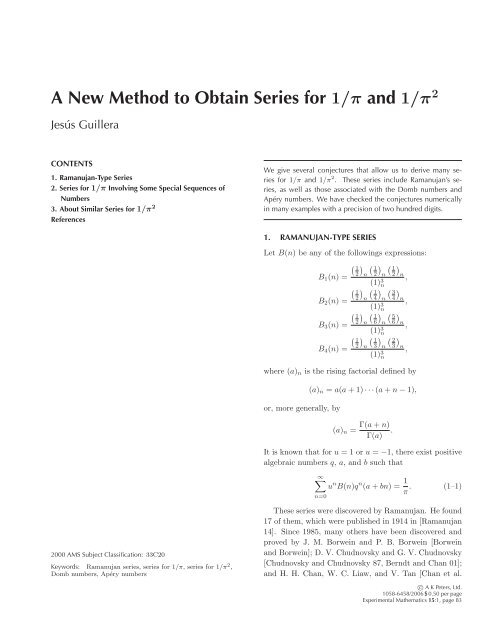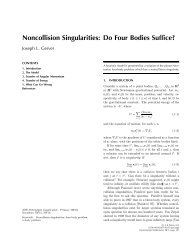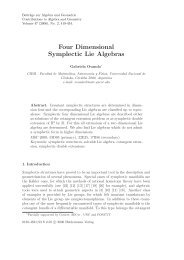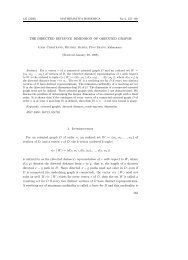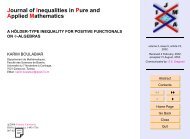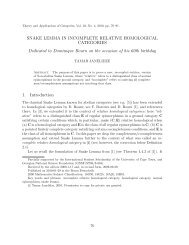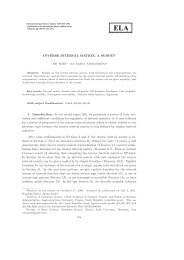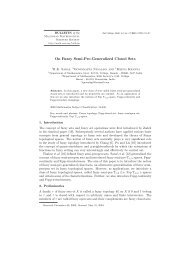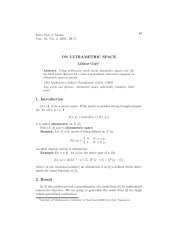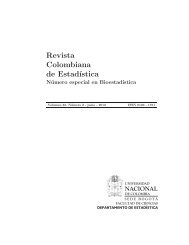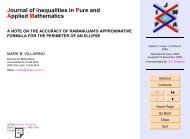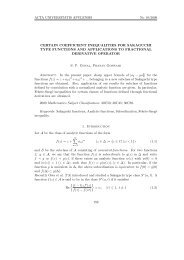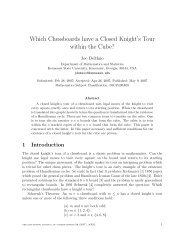View PDF - Project Euclid
View PDF - Project Euclid
View PDF - Project Euclid
- No tags were found...
Create successful ePaper yourself
Turn your PDF publications into a flip-book with our unique Google optimized e-Paper software.
A New Method to Obtain Series for 1/π and 1/π 2Jesús GuilleraCONTENTS1. Ramanujan-Type Series2. Series for 1/π Involving Some Special Sequences ofNumbers3. About Similar Series for 1/π 2ReferencesWe give several conjectures that allow us to derive many seriesfor 1/π and 1/π 2 . These series include Ramanujan’s series,as well as those associated with the Domb numbers andApéry numbers. We have checked the conjectures numericallyin many examples with a precision of two hundred digits.1. RAMANUJAN-TYPE SERIESLet B(n) be any of the followings expressions:( 1( 1) ( 1)B 1 (n) =2)n 2 n 2 n(1) 3 ,n( 1( 1) ( 3)B 2 (n) =2)n 4 n 4 n(1) 3 ,n( 1( 1) ( 5)B 3 (n) =2)n 6 n 6 n(1) 3 ,n( 1( 1) ( 2)B 4 (n) =2)n 3 n 3 n(1) 3 ,nwhere (a) n is the rising factorial defined byor, more generally, by(a) n = a(a +1)···(a + n − 1),(a) n =Γ(a + n).Γ(a)It is known that for u =1oru = −1, there exist positivealgebraic numbers q, a, andb such that∞∑u n B(n)q n (a + bn) = 1 π . (1–1)n=02000 AMS Subject Classification: 33C20Keywords: Ramanujan series, series for 1/π, series for 1/π 2 ,Domb numbers, Apéry numbersThese series were discovered by Ramanujan. He found17 of them, which were published in 1914 in [Ramanujan14]. Since 1985, many others have been discovered andproved by J. M. Borwein and P. B. Borwein [Borweinand Borwein]; D. V. Chudnovsky and G. V. Chudnovsky[Chudnovsky and Chudnovsky 87, Berndt and Chan 01];and H. H. Chan, W. C. Liaw, and V. Tan [Chan et al.c○ A K Peters, Ltd.1058-6458/2006 $ 0.50 per pageExperimental Mathematics 15:1, page 83
84 Experimental Mathematics, Vol. 15 (2006), No. 101, Chan et al. 04]. Since Ramanujan was the discovererof this kind of series, they are called Ramanujan-typeseries. Some examples are∞∑n=0∞∑n=0∞∑(−1) n B 3 (n)n=0(B 2 (n) 2206 √ 299 4n 9801((−1) n B 4(n)16 n)+ 52780√ 2n = 1 9801 π , (1–2)7 √ )336 + 17√ 312 n = 1 π , (1–3)( ( 3n 3 158) √ )2+ 77√ 264 32 n = 1 π . (1–4)The proofs of (1–2) and (1–3) can be found in [Borweinand Borwein] and [Chan et al. 01], respectively, and arebased on the theory of modular functions. A WZ-methodproof of (1–4) can be found in [Guillera 06a].Conjecture 1.1. When (1–1) holds for the positive algebraicnumbers a, b, andq, we conjecture the existenceof a positive rational number k = k(a, b, q) such that asx → 0,∞∑u n B(n + x)q n+x [a + b(n + x)] = 1 π − kπ 2 x2 + O(x 3 ).n=0(1–5)This conjecture is inspired by some series in [Guillera06b]. We have checked this conjecture numerically inmany examples and with a precision of two hundred digits.1.1 The Coefficient of the Next TermIn some cases we have also been able to identify the coefficientof the next term with the help of the followingfunction:∞∑σ 2 (x) =I(Li 2 (e ix sin nx)) =n 2 .n=1When q, a, andb are rational we find that the coefficientof the next term is a rational multiple of Catalan’sconstant G = σ 2 (π/2). Two examples are∞∑[B 1 (n + x) 564 n+x 16 + 42 ]16 (n + x)andn=0= 1 π − 3πx2 +64Gx 3 + O(x 4 )∞∑(−1) n B [2(n + x) 2318 2n+2x 72 + 65 ]18 (n + x)n=0= 1 π − 11π2 x2 + 160Gx 3 + O(x 4 ).When q, a √ 3, and b √ 3 are rational we find that thecoefficient of the next term is a rational multiple of theconstant A = σ 2 (π/3). Two examples areand∞∑n=0n=0[B 2 (n + x) 59 √ 37 4n+4x 49+ 120√ 3(n + x)49= 1 π − 8πx2 + 120Ax 3 + O(x 4 )[∞∑(−1) n B 4(n + x) 7 √ ]316 n+x 36 + 17√ 312 (n + x)= 1 π − 13π6 x2 +20Ax 3 + O(x 4 ).When q, a √ 2, and b √ 2 are rational we find that thecoefficient of the next term is a rational multiple of theconstant B = σ 2 (π/4) − G/4. Two examples are[√ ]∞∑(−1) n B 1(n + x) 28 n+x 4 + 3√ 22 (n + x)andn=0∞∑n=0= 1 π − 3π 2 x2 +32Bx 3 + O(x 4 )[B 2 (n + x) 2206 √ 299 4n+4x 9801]]+ 52780√ 2(n + x)9801= 1 π − 28πx2 + 1920Bx 3 + O(x 4 ).1.2 An Application of Conjecture 1.1If we define∞∑R(x) = u n B(n + x)q n+x [a + b(n + x)],n=0then (1–5) implies thatk = −R′′ (0),πand we can associate this positive rational number kwith every Ramanujan-type series. For example, forthe series (1–2), (1–3), and (1–4) we get respectivelyk =56,k=13/3, and k = 7. Moreover, we are going toshow that u, B(n), and k determine all the parametersof a Ramanujan-type series. To see this, we write∞∑u n B(n + x)q n+x [a + b(n + x)]n=0∞∑∞∑= a u n B(n + x)q n+x + b u n B(n + x)q n+x (n + x),n=0n=0
Guillera: A New Method to Obtain Series for 1/π and 1/π 2 85and define the functionsso thatS(x) =T (x) =∞∑u n B(n + x)q n+x , (1–6)n=0∞∑u n B(n + x)q n+x (n + x), (1–7)n=0R(x) =aS(x)+bT (x).From (1–5) we obtain the following system:aS(0) + bT (0) = 1 π , (1–8)aS ′ (0) + bT ′ (0) = 0.Using (1–5) and the values for a and b obtained fromsystem (1–8) we obtain an equationf(q) =k, (1–9)relating q and k for every binomial part B(n) andu =1or u = −1, wheref(q) = −aS′′ (0)π+ −bT ′′ (0).πBy numerical experimentation we have discovered analgorithm to solve (1–9): First we get a good first approximationq 1 to q if instead of S(x) andT (x) we solve(1–9) using the functions B(x)q x and B(x)q x x, obtainedby taking only the terms n = 0 in (1–6) and (1–7). Thisis a second-degree equation in ln(q), and one of its solutionsfor q 1 is invalid because it is greater than unity; theother one is (1–21). Next, we use the formulaln q n= ln q n+1,k n kobtained by considering the linear relation between k andln q. So, to get better approximations of q we can use therecurrencek n = f(q n ),q n+1 = q k/knn . (1–10)Our interest is to guess q when k is a rational number. So,after finding the numerical approximation of q, wetrytoobtain the algebraic expression of it. The functions identify(see [Borwein et al.]) and minpoly, implemented inMaple 9, are adequate for this purpose. When we getq, the system (1–8) allows us to obtain numerical approximationsof a and b, and again we must guess whichalgebraic numbers they are. We give an example of theprocedure: Take u =1andB(n) =B 2 (n). Then substitutingk = 4 in (1–9) and using the recurrence (1–10)with the initial value (obtained as explained before)q 1 = 256 e −π√6 ,we get the following sequence of approximations:We easily guess thatn q n k n1 0.1164700015 3.9230875362 0.1116624439 3.9919033913 0.1111670393 3.9991766794 0.1111167760 3.9999165855 0.1111116848 3.9999915526 0.1111111692 3.9999991447 0.1111111169 3.9999999138 0.1111111117 3.9999999919 0.1111111111 3.99999999910 0.1111111111 3.99999999911 0.1111111111 4.000000000q =0.1111111111 ...= 1 9 .Substituting this value in (1–8), we obtaina =4.618802153517 and b =0.577350269189,and the function identify of Maple 9 (see [Borwein et al.]),recognizes these constants asa = 8 √ 1√ 3 and b = 3. (1–11)33In the following examples we use the function identifyto recognize the constants: Take u = 1 and B(n) =B 1 (n). Then for k =4,weget√10 √ 5 − 22, b =√20 √ 5 − 40.q =9− 4 √ 5, a = 1 2(1–12)Take u = −1 andB(n) =B 1 (n). Then for k =5,wegetq =17− 12 √ 2, a =2 √ 2 − 5 2 , b =6√ 2 − 6. (1–13)For the alternating series associated with k = 15 andcorresponding to the binomial parts B 3 (n) andB 4 (n) weget, respectively, the following parametersq = 1512 , a = 25 √ 57√ 6, b = 6, (1–14)192 32andq = 13024 , a = 13 √ 55√ 7, b = 7. (1–15)108 36
86 Experimental Mathematics, Vol. 15 (2006), No. 11.3 The Number NFrom (1–8) we obtaina = 1 πb = 1 πT ′ (0)S(0)T ′ (0) − S ′ (0)T (0) , (1–16)−S ′ (0)S(0)T ′ (0) − S ′ (0)T (0) , (1–17)and substituting these values in (1–9) we obtainS ′′ (0) + kπ 2 S(0)S ′ (0)= T ′′ (0) + kπ 2 T (0)T ′ . (1–18)(0)We now define the number N as[ S ′′ (0) + kπ 2 ] 2S(0)N :=−2πS ′ . (1–19)(0)Numerical experimentation with many examples revealsthat N and k are related in a simple way that dependsonly on the binomial part B(n). For B 1 (n), B 2 (n),B 3 (n), and B 4 (n) we have respectively N = k +1,N = k +2, N = k +4, and N = k + 4 3. For example,for the series (1–2), (1–3), (1–11), (1–12), (1–13), (1–14),(1–15), we get in the same order N = 58, N =17/3,N =6,N =5,N =6,N = 19, and N =49/3. Directobservation of these values allows us to guess that thenumber N was used in the modular theory of Ramanujantypeseries as a parameter to obtain a = a(N), b = b(N),and q = q(N) (see [Borwein and Borwein], [Chan et al.04]). From (1–18) and (1–19), we get the following system:S ′′ (0) + kπ 2 S(0) = −2π √ NS ′ (0),T ′′ (0) + kπ 2 T (0) = −2π √ NT ′ (0).Differentiating the first equation of the system with respectto q, and simplifying using the second, we getπ dkdq S(0) = − 1 √NdNdq S′ (0),but for the four cases relating N and k, wehaveSo we obtaindNdq = dkdq .S ′ (0) = −π √ NS(0), (1–20)and instead of (1–9) we can use this simpler equation (itdoes not involve second derivatives) to get the value of qfor a choice of u, B(n), and N. To solve it, we define thepartial sum S j (x) ofS(x),and solvingS j (x) =j∑u n B(n + x)q n+x ,n=0S ′ 0(0) = −π √ NS 0 (0),we get a first approximation of q,q 1 = Me −π√N , (1–21)where M =64ifB(n) =B 1 (n), M = 256 if B(n) =B 2 (n), M = 1728 if B(n) = B 3 (n), and M = 108 ifB(n) =B 4 (n). Then we get better and better approximationsof q by means of the recurrence( qn) √ N/N nN n = f(q n ), q n+1 = M,Mor using the recurrence (1–10), where f(q) is the function(see (1–20))[ S ′ ] 2(0)f(q) =.−πS(0)We can now state the following conjecture.Conjecture 1.2. For some rational numbers N, the solutionq of (1–20) and the values of a and b obtained bysubstituting that value of q in (1–16) and (1–17) are positivealgebraic numbers that can be used to get an identityof the form (1–1).2. SERIES FOR 1/π INVOLVING SOME SPECIALSEQUENCES OF NUMBERSIn this section we consider series of the form (1–1) associatedwith some special sequences of numbers, whichare motivated by [Almkvist and Zudilin 03], [Chan 05],and [Yang 04], for example to the Domb numbersB(n) =n∑( njj=0to the Apéry numbersto the numbersB(n) =B(n) =) 2 ( 2jj)( ) 2n − 2j, (2–1)n − jn∑( ) 2 ( ) 2 n n + j, (2–2)j jj=0n∑j=0( 2jj) 2 ( ) 2 2n − 2j, (2–3)n − j
Guillera: A New Method to Obtain Series for 1/π and 1/π 2 87or to the numbersB(n) =n∑( ) 4 n. (2–4)jj=0If we call B(n + x) the functions obtained by replacingn by n + x except in the summation symbols, then webelieve that Conjecture 1.2 is also true for these series.We give the series found by applying it for N = 3 withu = 1 and the numbers (2–3), for N =38/5 with u =1and the numbers (2–4), and for N =17/5 with u = −1and the numbers (2–4):∞∑n=0 j=0n=0 j=0n=0 j=0n∑( 2jj(1) 2 ( ) ( 2 2n − 2jn − j)2 − √ ) n364×4 + 3+2√ 3n = 1 4 π ,∞∑ n∑( ) (4 n 1 47 √ )95j 76 2n 1444 + 102√ 95n = 1 361 π∞∑ n∑( (4 n (−1)j) n 4 √ )518 2n 27 + 68√ 581 n = 1 π .Series for 1/π using the Apéry numbers (2–2) werepresented in a talk by T. Sato [Sato 02]. Motivated bythese, similar series associated with the Domb numbers(2–1) have been studied and proved in [Chan et al. 04].Y. Yang has proved similar evaluations using the numbers(2–4) and following essentially the same method [Yang05].3. ABOUT SIMILAR SERIES FOR 1/π 2We now consider series of the form∞∑u n B(n)q n (a + bn + cn 2 )= 1 π 2 , (3–1)n=0where u = 1 or u = −1; a, b, c, q are positive algebraicnumbers; and (1) 5 nB(n) is the product of five risingfactorials of fractions smaller than unity satisfying thefollowing condition: For every denominator in the fractionof a rising factorial, we have rising factorials with allpossible irreducible fractions corresponding to that denominator.Some examples for the binomial part B(n)are( 1( 1) ( 1) ( 1) ( 1)B 1 (n) =2)n 2 n 2 n 2 n 2 n(1) 5 ,n( 1) ) ) )2)B 2 (n) =n( 12n( 12(1) 5 nn( 14n( 34n,B 3 (n) =B 4 (n) =B 5 (n) =( 12)( 12)( 12)( 12)n( 14n( 13n( 13n( 18))))n( 34)(1) 5 n)n( 23(1) 5 n)n( 23(1) 5 n)n( 38n( 16n( 14n( 16n( 58))))n( 56n( 34n( 56n( 78B 6 (n) =(1) 5 .nI proved three identities of the form (3–1) in [Guillera02] and [Guillera 06a], and inspired by its form I found,without proving them, four more identities of the samekind in [Guillera 03].Conjecture 3.1. When (3–1) holds for the positive algebraicnumbers a, b, c, andq, we conjecture the existenceof a positive rational number k = k(a, b, c, q) such that asx → 0,∞∑u n B(n + x)q n+x [a + b(n + x)+c(n + x) 2 ] (3–2)n=0= 1 π 2 − k 2 x2 + O(x 4 ).This conjecture is inspired by some series in [Guillera06b]. For all the series we have found, we have also beenable to recognize the coefficient of the next term as arational multiple of π 2 . One example is∞∑(−1) n B (4(n + x) 548 n+x 48 + 21)16 (n + x)+21 4 (n + x)2n=0= 1 π 2 − 3 2 x2 + 157π224 x4 + O(x 5 ). (3–3)3.1 An Application of Conjecture 3.1If we define∞∑R(x) = u n B(n + x)q n+x [a + b(n + x)+c(n + x) 2 ],n=0then (3–2) implies thatk = −R ′′ (0),and we can associate this positive rational number k withevery series of the form (3–1). For example, for the series(2-4) in [Guillera 03],(∞∑(−1) n B 5(n) 29 √ )580 3n 640 + 693√ 5640 n + 5418√ 5n 2 = 1 640 π 2 ,n=0(3–4)))))nnnn,,,
88 Experimental Mathematics, Vol. 15 (2006), No. 1we get k = 15. Moreover, we are going to show that u,B(n), and k determine all the parameters of this kind ofseries. To see this, we write∞∑u n B(n + x)q n+x [a + b(n + x)+c(n + x) 2 ]n=0∞∑∞∑= a u n B(n + x)q n+x + b u n B(n + x)q n+x (n + x)+ cn=0n=0∞∑u n B(n + x)q n+x (n + x) 2 ,n=0and define the functions∞∑S(x) = u n B(n + x)q n+x ,so thatT (x) =U(x) =n=0∞∑u n B(n + x)q n+x (n + x),n=0∞∑u n B(n + x)q n+x (n + x) 2 ,n=0R(x) =aS(x)+bT (x)+cU(x).From (3–2) we obtain the following system:aS(0) + bT (0) + cU(0) = 1/π 2 ,aS ′ (0) + bT ′ (0) + cU ′ (0) = 0, (3–5)aS ′′′ (0) + bT ′′′ (0) + cU ′′′ (0) = 0.Using (3–2) and the values for a, b, andc obtained fromthe system (3–5) we obtain an equationwheref(q) =k, (3–6)f(q) =−aS ′′ (0) − bT ′′ (0) − cU ′′ (0),that relates q with k for every binomial part B(n) andu =1oru = −1. Equation (3–6) can be solved in thesame way as (1–9), but this time the first approximationfor ln q 1 is a solution of a third-degree equation. The recurrence(1–10) can be used again to obtain q numericallywhen we select a value for k. Our interest is to guess qwhen k is a rational number. So, after finding the numericalapproximation of q, we try to guess its algebraicexpression. When we get q, the system (3–5) allows usto obtain the values of a and b, and again we must tryto guess these numbers. We give an example of the procedure:Take u = −1, B(n) =B 1 (n), and k =5. Tosolve (3–6) we take, as initial value q 1 , the only solutionsmaller than unity of the equation of third degree in ln q(obtained as explained before)ln 3 q − 30 ln 2 ln 2 q + (300 ln 2 2 − 20π 2 )lnq+ [200π 2 ln 2 − 1000 ln 3 2 − 60ζ(3)] = 0.Using the recurrence (1–10), we get the following sequenceof better and better approximations:n q n k n1 0.000976266984418 5.000279495912 0.000976645321010 4.999921684973 0.000976539294280 5.000021944474 0.000976569002482 4.999993851045 0.000976560677972 5.000001722986 0.000976563010544 4.999999517217 0.000976562356942 5.000000135288 0.000976562540086 4.999999962099 0.000976562488768 5.0000000106210 0.000976562503147 4.9999999970211 0.000976562499118 5.0000000008312 0.000976562500247 4.9999999997713 0.000976562499931 5.0000000000714 0.000976562500019 4.9999999999815 0.000976562499995 5.0000000000116 0.000976562500002 5.0000000000017 0.000976562500000 5.0000000000018 0.000976562500000 5.00000000000And we easily guess thatq =0.0009765625 = 11024 .Substituting this value in (3–5), we geta =0.101562500000, b =1.406250000000,c =6.406250000000,and again, we easily guess thata = 13128 , b = 180128 , c = 820128 ,which correspond to the series (1-1) in [Guillera 03]. Wegive two more examples: Taking k = 15 and using therecurrence (1–10) to solve (3–6), we rediscover the series(3–4). Taking k = 8 we rediscover the series (2-5) in[Guillera 03]:∞∑n=0(B 6 (n) 15 √ )77 4n 392 + 38√ 749 n + 240√ 7n 2 = 1 49 π 2 .
Guillera: A New Method to Obtain Series for 1/π and 1/π 2 89REFERENCES[Almkvist and Zudilin 03] G. Almkvist, W. Zudilin. “DifferentialEquations, Mirror Maps and Zeta Values.” In Proceedingsof the BIRS Workshop “Calabi–Yau Varietiesand Mirror Symmetry” (Banff, December 6–11, 2003),edited by J. Lewis, S.-T. Yau, and N. Yui. Cambridge,MA: International Press, and Providence, RI: AmericanMathematical Society, 2003.[Berndt and Chan 01] B. C. Berndt and H. H. Chan. “EisensteinSeries and Approximation to π.” Illinois Journal ofMathematics 45 (2001), 75–90.[Borwein and Borwein] J. M. Borwein and P. B. Borwein. Piand the AGM. New York: Wiley Interscience, 1987.[Borwein et al.] P. B. Borwein, K. G. Hare, and A. Meichsner.“Reverse Symbolic Computations, the identify Function.”Preprint.[Chan et al. 01] H. H. Chan, W. C. Liaw, and V. Tan. “Ramanujan’sClass Invariant λ n and a New Class of Seriesfor 1/π.” Journal of the London Mathematical Society 64(2001), 93–106.[Chan et al. 04] H. H. Chan, S. H. Chan, and Z. Liu. “Domb’sNumbers and Ramanujan–Sato Type Series for 1/π.” Advancesin Mathematics 186 (2004), 396–410.[Chan 05] H. H. Chan. “Some New Identities Involving π,1/π and 1/π 2 .” Manuscript, 2005.[Chudnovsky and Chudnovsky 87] D. V. Chudnovsky andG. V. Chudnovsky. “Approximations and Complex MultiplicationAccording to Ramanujan.” In Ramanujan Revisited:Proceedings of the Centenary Conference, UniversityofIllinois at Urbana-Champaign, June 1–5, 1987,edited by G. E. Andrews, B. C. Berndt, and R. A. Rankin,pp. 375–472. Boston: Academic Press, 1987.[Guillera 02] J. Guillera. “Some Binomial Series Obtained bythe WZ-Method.” Advances in Applied Mathematics 29(2002), 599–603.[Guillera 03] J. Guillera. “About a New Kind of RamanujanType Series.” Experimental Mathematics 12 (2003), 507–510.[Guillera 06a] J. Guillera. “Generators of Some RamanujanFormulas.” The Ramanujan Journal 11 (2006), 41–48.[Guillera 06b] J. Guillera. “Hypergeometric Identities for 10Extended Ramanujan Type Series.” To appear in The RamanujanJournal.[Ramanujan 14] S. Ramanujan. “Modular Equations and Approximationsto π.” Quarterly Journal of Mathematics 45(1914), 350–372.[Sato 02] T. Sato. “Apéry Numbers and Ramanujan’s Seriesfor 1/π.” Abstract of a talk presented at The AnnualMeeting of the Mathematical Society of Japan, March 28-31, 2002.[Yang 04] Y. Yang. “On Differential Equations Satisfied byModular Forms.” Mathematische Zeitschrift 246 (2004),1–19.[Yang 05] Y. Yang. Personal communication, 2005.Jesús Guillera, Av. CesáreoAlierta31esc.izda4 ◦ A, Zaragoza, 50008, Spain (jguillera@able.es)Received January 31, 2005; accepted October 6, 2005.


